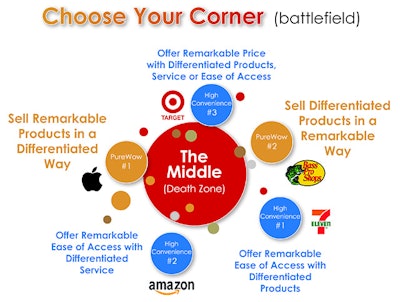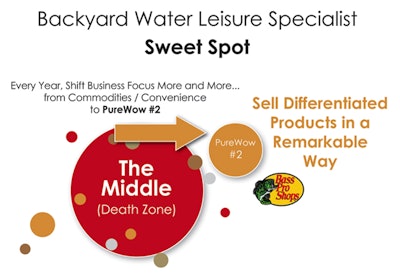This series focuses on guiding you with concepts, practical strategies and tactics to create what we refer to as a “High Fidelity Business” — a business refocused on a new market position, offering predominately differentiated products and services in remarkable ways. In this industry, we're specifically addressing how to deliver a new, more relevant value proposition: creating remarkable backyard experiences. One way of doing that is by using the "David Strategy," an idea inspired by the classic David and Goliath fable. Here, we delve a little more into how pool and spa retailers can best stand out from their competition.
As I discussed in my last blog post, the principal strategy David deployed in his triumph over Goliath was choosing his battlefield and strategy based on his strengths, not his enemy’s strengths. Today's post will focus on exploring the diagram below, providing you with deep insights on how you can shift to what retail expert Doug Stephens refers to as a "High Fidelity #2 business strategy" in his book "Retail Revival."
Let’s begin by reviewing the diagram below. We'll start by taking a look at each part and how together they set the stage for what's to come in the rest of this series.

The colors of each bubble are significant. Red refers to “red ocean” business strategies, defined by continuously challenged or declining revenues and fickle and decreasing customer loyalty. Companies that fall in this area are highly likely to see declining business profitability, especially in today's age of showrooming.
This approach to competing is characterized by largely undifferentiated products and increasingly downward pressure on margins. In this arena, convenience, scale and price generally wins the day, but offers consumers little reason not to switch to a company with a more convenient location or lower prices. Wal-Mart is a good example of this, along with big box stores and price-oriented Internet companies. This approach works for those companies, but it's not ideal for specialty pool and spa stores — after all, who can out-Wal-Mart Wal-Mart? Not you; you will never beat Wal-Mart at being Wal-Mart.
Yes, like Wal-Mart, your business has to have some commodities, but you must decrease your focus and reliance on “red” commodities at every opportunity.
The blue bubbles denote business designs that have found a defensible position largely by focusing on convenience and some other component that is distinctly value-added. The three blue convenience strategies are “successful, sustainable and profitable,” but typically also require large scale to work, something that's not a viable option for pool and hot tub retailers. Visit each of the blue bubbles; adjacent to each is its core strategy and an example of a business that does well in that area.
An interesting example is Target. They have found a very successful way to compete with Wal-Mart: upshifting and focusing on product differentiation, and offering attractive (but not the lowest) pricing. Better brands, quality, convenience and good value pricing. (They also add a dash of class, which doesn't hurt either.)
Target is also a good example when considering the cost of straying from a successful business design. A few years ago, they entered the Canadian market in a big way and retreated just two years later, losing billions in the process. Why? Because they did not follow their successful business model in Canada. Instead, they dramatically downshifted their product selection and quality without reducing accordingly — in short, they took on Wal-Mart head-to-head in the red zone and got a whomping.
Finally, let’s shift to the gold-hued “High Fidelity” business designs, known as the most profitable and defensible companies out there. The gold standard is Apple, which has what we call a "High Fidelity #1" business strategy.
What makes Apple different is that they have a continuous stream of remarkable products sold in a differentiated way. Steve Jobs’ legacy was not just about bringing the best and newest technology to market; Apple’s formula is all about "remarkable" items that exude sophistication, invite you to touch and feel and come in sleek packaging. Overall, it's a very cool customer experience.
They're clearly doing something right because Apple is the world's most profitable company. And they got there because they know their sweet spot and focus every aspect of the business on creating employee and customer “tribes” addicted to new, cool and better. This is something you can learn from.
However, there's an even better example you can learn from, too. Look to the upper right of the chart above and you'll see the gold "PureWow #2 bubble," which denotes differentiated products sold in remarkable ways. This is the spot for pool and spa retailers, and it's the place where the David Strategy works best.
The best example of this model can be seen by visiting your local Bass Pro Sports Shop. I know it’s a big footprint store, but think of a “boutique” version of what they do, focused on creating remarkable water wellness environments.
Here is a visual summary of the David Strategy’s focus:

Bass Pro Sports focuses on attracting consumers who wish to optimize outdoor leisure sports pursuits, which they do by selling differentiated products in a distinctive way. It’s not that different from creating remarkable backyard water wellness experiences, so there's lots you can learn from from Bass Pro's example.
If you don’t know a lot about Bass Pro, visit a store with a fresh set of eyes. They have gone from one store to one hundred across North America, and generate almost 5 BILLION dollars in revenue in a highly commoditized market. They create “tribes,” not just customers. They segment their customers into categories, focus on differentiated products and follow a “good, better, best” strategy on product ranging. They appeal to their customers' passions, focus on how to optimize their clients’ experiences and offer an exceptional and remarkable “treasure hunt” customer experience. Bass Pro is not just a store — it's a tourist attraction in most communities.
Believe me, there's a lot you can learn from the Bass Pro model to strengthen your David Strategy and reinvent your store into a much more profitable pool and hot tub business. Tired of fighting an unwinnable battle against “Goliath?” Trust me, as a leader, committing your business to a High Fidelity #2 Business Strategy is the place to start. Remember, it is not about changing everything, it is about refocusing your business where your gut tells you is the right place to be, and then diving into it with a passion.
Discussion:
Using what you have learned in this post and your knowledge of the pool and hot tub industry, which “strategy circle” do you think most pool and hot tub businesses currently are competing in?
Dennis Gray is the co-founder — along with one of the most experienced teams of innovative industry professionals — of Backyard Brands Inc., and former President of Biolab’s International Group of companies. Backyard Brands is focused on one mission: to develop differentiated and remarkable backyard water wellness products sold exclusively through Backyard Leisure Professionals who have a passion for reinventing their businesses to compete more successfully in this new age. If you wish to explore two examples, please visit mineraluxewater.com and pristiva.net. Check out our “High Fidelity” approach with our dealers on backyard social responsibility: sharethegiftofwater.com.











































